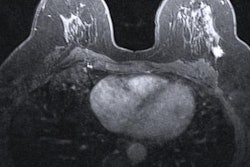
Breast MRI is the most sensitive tool for detecting breast cancer, but its cost and time requirements often hinder its use, according to a new study published April 17 in the American Journal of Roentgenology. Yet with the development of an abbreviated MRI protocol, the modality is becoming an increasingly viable option.
So how exactly can a department put an abbreviated MRI breast imaging protocol into place? A team led by Dr. Holly Marshall of University Hospitals Cleveland Medical Center offered five steps to take.
Choose a protocol. Different abbreviated MRI protocols have been evaluated in clinical literature. Marshall's department uses the EA1141 study (Abbreviated Breast MRI and Digital Tomosynthesis Mammography in Screening Women With Dense Breasts) protocol, which takes less than 10 minutes and includes the following:
- Localizer sequences
- An axial T2-weighted short tau inversion-recovery (STIR) sequence
- An axial T1-weighted sequence with fat saturation before and after IV administration of gadolinium contrast
Set a schedule. Marshall's department schedules three 10-minute abbreviated MRI studies (which it calls fast MRI) in a one-hour time slot -- the time allotted for a full-protocol MRI exam, the group wrote. The department mixes these fast MRI hours into the regular schedule.
Begin billing. Setting up pricing and billing for abbreviated MRI can take a while, Marshall and colleagues found: It took them 10 months to establish pricing through the hospital's finance department. The exam is out of pocket for patients because no current procedural terminology (CPT) code exists for it.
"Many patients with high-deductible insurance plans have a lower out-of-pocket expense for [abbreviated] breast MRI than for full protocol," the group noted.
Educate patients and referring physicians. Marshall's team presented the concept of abbreviated MRI to the hospital's breast program leadership, which includes surgeons, medical oncologists, radiation oncologists, pathologists, and medical breast clinicians. It also created online educational resources for referring physicians and patients about the fast MRI exam.
"If there is any question about a patient's risk, the clinician and patient are encouraged to make an appointment at our high-risk clinic for evaluation," Marshall and colleagues noted.
Audit yourself. Marshall's department found that after three months of using the fast MRI exam, its rate of BI-RADS 3 findings was higher than expected. So the department established bimonthly conferences to review cases categorized as BI-RADS 3 or higher.
"This discussion among radiologists along with regular bimonthly conferences has helped reduce the number of BI-RADS 3 assessments," the authors wrote.
Setting up an abbreviated breast MRI program takes time and commitment, Marshall and colleagues cautioned. In fact, it took University Hospitals Cleveland a full year. But it's worth it.
"The days of personalized screening have arrived," the group concluded. "We believe it is vital to our breast imaging practice to educate patients about their breast density and to offer multiple screening options, particularly to patients with dense breast tissue, to maximize the impact of screening on the morbidity and mortality of breast cancer."




.fFmgij6Hin.png?auto=compress%2Cformat&fit=crop&h=100&q=70&w=100)




.fFmgij6Hin.png?auto=compress%2Cformat&fit=crop&h=167&q=70&w=250)











